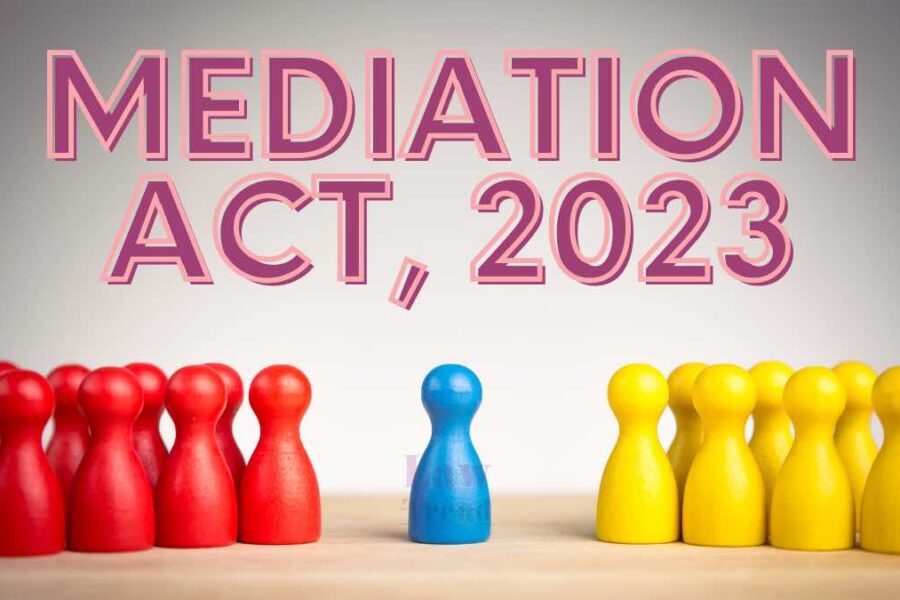Introduction
The passage of the Mediation Act, 2023, marks a major leap for India to formalize and encourage alternative dispute resolution (ADR) processes, particularly mediation. Mediation existed for years under a rather informal or court-annexed system without having a separate statutory framework. The Mediation Act, 2023 has revolutionized this landscape by enacting the principles, procedures, and institutional structures for mediation in India. This article analyzes the salient features of the Act, its importance, and its ability to revolutionize the system of dispute resolution.
The Need for a Mediation Law
Until 2023, mediation in India was regulated by sporadic provisions under laws like the Code of Civil Procedure, 1908, Arbitration and Conciliation Act, 1996, and rules of different High Courts. But there was no uniform law, so there existed inconsistency in process, uncertainty in enforcement, and limited institutional infrastructure. The pendency of cases in Indian courts also emphasized the importance of a strong ADR mechanism. Against this context, the Mediation Act, 2023 offers a formal framework to mediation with a view to curbing litigation and facilitating amicable settlements.
Salient Features of the Mediation Act, 2023
1. Definition and Scope of Mediation
The Act defines mediation in clear terms and differentiates it from other modes of ADR such as arbitration and conciliation. Mediation is described as a consensual process whereby parties try to settle a dispute with the help of a neutral third person referred to as a mediator. The Act also has provisions for both court-referred and private mediation.
2. Pre-litigation Mediation as Mandatory
One of the main features of the Act is mandatory pre-litigation mediation of civil and commercial cases. Prior to going to court, parties must now go through the mediation process first. This step is expected to weed out cases that are capable of settlement through amicable means and, therefore, de-congest the courts.
3. Formation of the Mediation Council of India (MCI)
The Act provides for the creation of the Mediation Council of India, which is a central authority that will register mediators, approve mediation service providers and institutions, and formulate guidelines and standards. This central authority will provide uniformity and quality to mediation services in the country.
4. Recognition and Enforcement of Mediated Settlement Agreements
One of the significant issues with mediation was enforceability of settlements. The Mediation Act solves this by providing the status of a decree of court to an agreement arrived at through mediation, so that it becomes enforceable under the Code of Civil Procedure, 1908. This adds legal certainty and finality to mediation outcomes.
5. Confidentiality and Privilege
The Act highlights the confidentiality of the process of mediation and that all communications, proposals, and documents made in the process of mediation are safeguarded and cannot be admissible in subsequent proceedings. This makes parties feel free to communicate openly without the fear of legal action.
6.Online Mediation
Realizing the digital transformation of legal services, online mediation is also provided for by the Act to make the process more affordable and accessible, particularly to parties in distant areas or with mobility issues.
Benefits of the Mediation Act, 2023
1. Reduces Court Backlog: With a million cases pending, mediation provides a faster and less formal means of dispute resolution.
2. Holds Relationships Together: particularly in family and business conflicts, mediation holds relationships together by promoting collaboration instead of warlike confrontations.
3. Cost-Effective: Mediation is usually cheaper than court cases and arbitration, making justice more affordable.
4. Time-Efficient: Cases can be solved in weeks or months as opposed to years in court.
5. Empowers Parties: Mediation provides parties with the power to shape the resolution, as opposed to courts where outcomes are imposed.
Challenges and Concerns
1. Awareness and Acceptance: Most individuals are still unaware of mediation or doubtful about its efficacy. Extensive awareness drives and legal literacy programs are the need of the hour.
2. Quality of Mediators: The success of mediation largely rests on the mediator’s skill and impartiality. Proper training and certification are a must.
3. International Enforceability: Though domestic enforcement has been addressed, the Act is not yet harmonized with the Singapore Convention on Mediation to which India is a signatory but not a ratifier.
4.Exclusion of Disputes: The Act excludes certain issues such as criminal offenses, tax disputes, and rights in rem. It is still uncertain what can and cannot be mediated, and it may require litigation to ascertain.
Role of Legal Professionals and Institutions
The functioning of lawyers is not reduced under this Act. Rather, they are urged to become more conciliatory. Law schools, bar councils, and judicial academies are required to incorporate mediation courses into their curriculum. Organizations such as India International Arbitration Centre (IIAC) and many High Court Mediation Centres need to extend their activities under the new system.
Conclusion
The Mediation Act, 2023 is a forward-looking step towards fulfilling the constitutional obligation of ensuring effective and affordable access to justice. It places mediation where it belongs in the Indian legal landscape and takes us closer to the international trend of institutional ADR. But whether the Act succeeds will be determined by its implementation, infrastructure development, and cultural transition towards consensual dispute resolution.
By inviting dialogue rather than dispute, and compromise rather than confrontation, the Act is evidence of a mature legal system—one as interested in reconciliation as in rights.
Contributed By: Diwanshi Arya (Intern)

